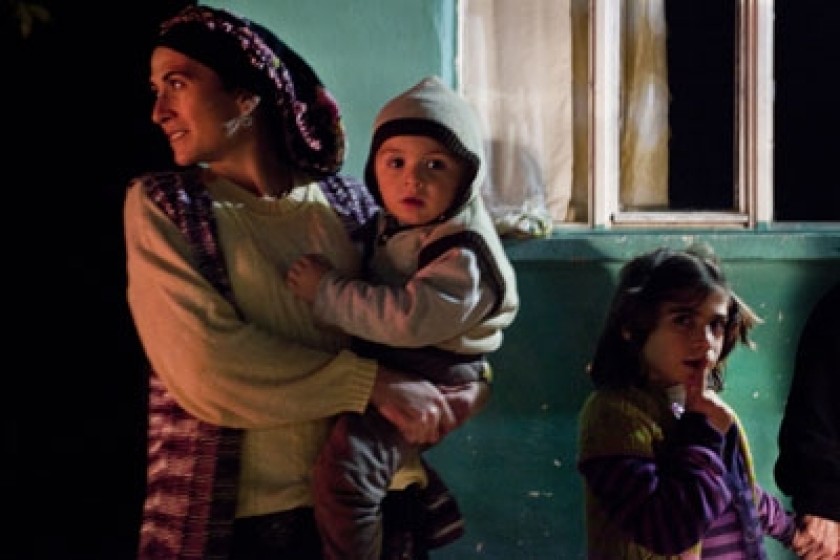
The Armenian-Speaking Muslims of Hamshen: Who Are They? (Part 3)
By Vahan Ishkhanyan
Communist Hopa: “I am Armenian. My history is my grandfather”
The Hayteh Bar in Hopa is one of those rare places where you won’t see a portrait of Ataturk.
“He’s my Ataturk,” says a communist Hamshentsi pointing to a photo of an old man, the communist Nuri Yasataghis; nicknamed “Doctor”.
Here, the word “communist” speaks more about conviction than party affiliation. In Turkey today, a Communist Party does indeed exist, but it is ridiculed by the left as a creation of the ruling regime in order to present a democratic face to the West.
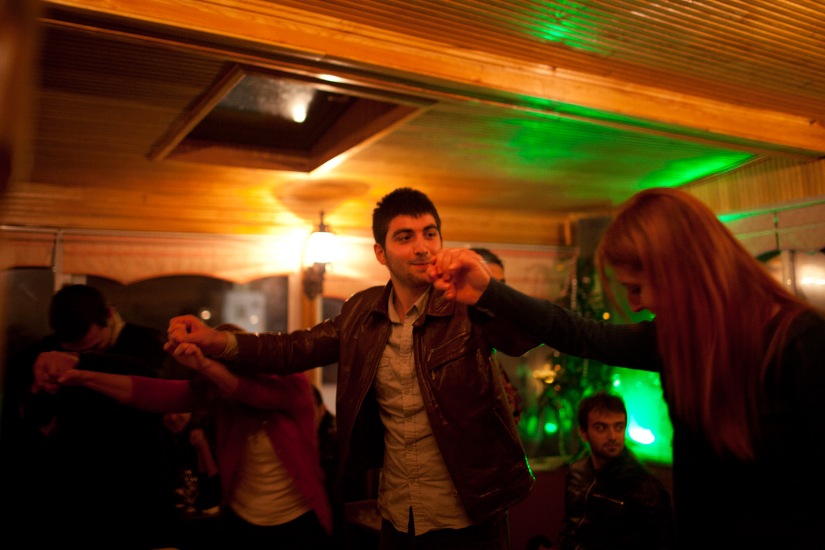 |
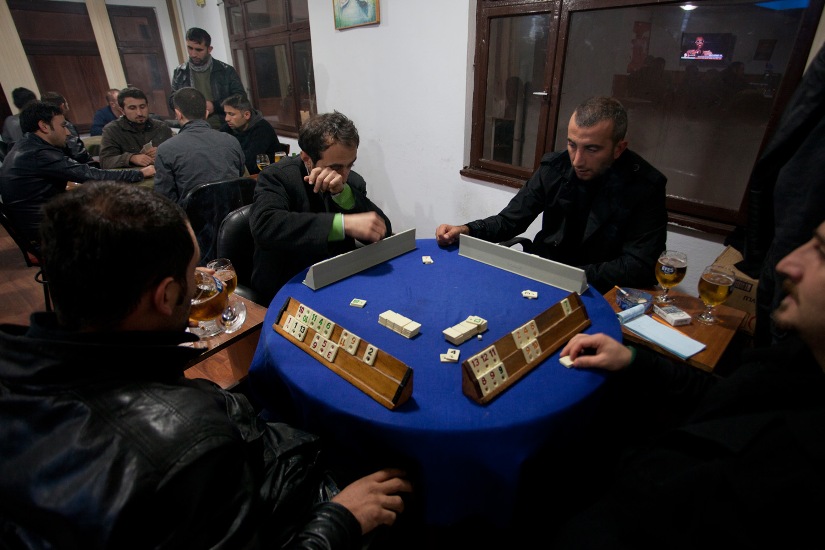 |
| Hopa: Hayteh Bar - Hamshens dance the horon; a circle dance from the mountain valleys
|
Hopa: Hayteh Bar - Beer, raki and games |
Out of Hopa’s population of 17,000, some 7,000 are Hamshens, 7,000 are Laz, and the remainder is comprised of other ethnic groups.
As a Black Sea cultural city, the two narrow central thoroughfares of Hopa bustle with public life. Up and down the streets, men can be seen drinking tea, playing backgammon and getting a haircut. At the end of the street is the mosque from which a loudspeaker blares out the adhan (call to prayer). In the basement bars, you’ll come across prostitutes from former Soviet countries ready to gratify the needs of road-weary drivers.
If you have seen the film Autumn by Özcan Alper, a portion of which was shot in Hopa, you’ll experience déjà vu if you travel to Hopa in the fall. It’s all here – the rain, the cold sea winds, and the Georgian prostitutes. In contrast to the film, however, in which a Georgian flesh peddler calls relatives back home from a street telephone-box, she can now be seen angrily talking into a cell phone on the steps leading to a nightclub.
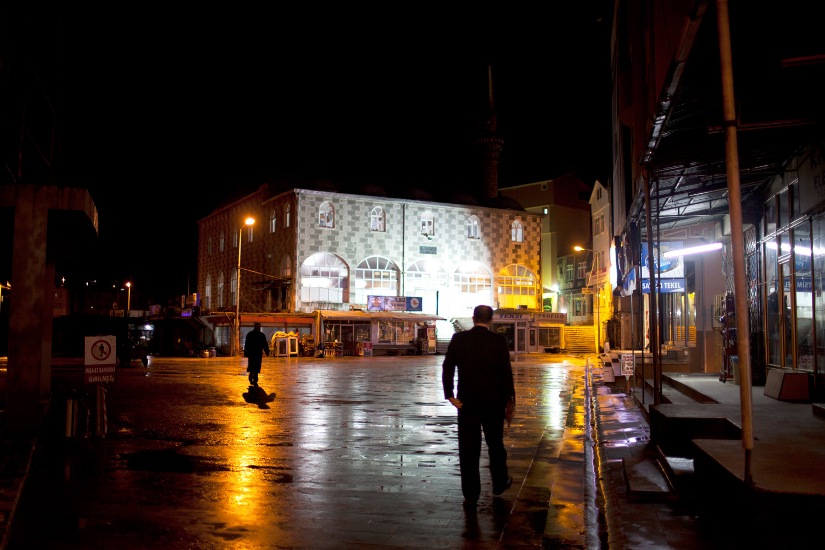 |
| Call to Prayer: A mosque’s loudspeaker sends the message across the city |
“Where can go to have a couple of quiet beers?” Khachik asks one of our Hamshen friends. He shakes his head, as if to say that we should avoid the nightclubs, and looks towards the upper floor of a building across from us. It’s the revolutionary Hayteh Bar owned by Harun Aksu.
Where does Mumi Yılmaz know us from? As soon as we step foot into the bar he holds out his hand in welcome and says – I’m also Armenian. We join them at a table - raki, tea, beer? Efes, the Turkish beer, is quite good. The three friends are drinking raki, which turns a milky white after they pour some water into their glasses.
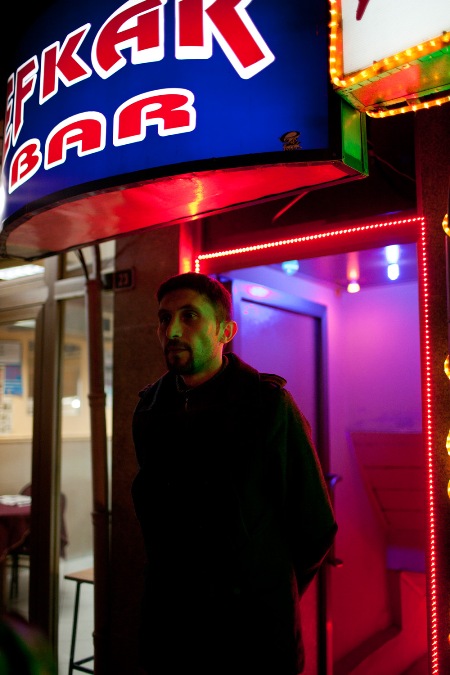 |
| Hopa: This nightclub is one of the many places to come across women from post-Soviet countries plying the “world’s oldest profession” |
“We know about your cause, we are of the same blood,” says Mumi exposing the veins on his arm. “We are brothers, we are all Armenian.”
His friend Naci was in Armenia fifteen years ago. He says that upon crossing the border into Armenia from Geogia, he knelt down and kissed the ground. Chuckling, he then adds, “American, Armenian, Georgia, Azerbaijani, they’re all human beings. There’s no problem other than the one in people’s heads.”
“How do you know that you’re Armenian? You don’t any of the history,” asks Harun after listening to Mumi.
These words sting Mumi. Later on, we go to a small store, sit on stools, and order some bottles of beer. Mumi can’t shake the rebuke leveled by Harun and responds in kind.
- Where does Harun get off saying such a thing? I don’t need to know the history to say that I’m Armenian. My grandfather is my history. He told me that it’s the truth. Whatever I know comes from him. My grandfather came down from the mountains to sell whatever he had, a bit of milk, oil, whatever. They caught him, called him Armenian, and bashed his head in. They stole his belongings, his horse, everything.
- Before, in the mountains, they made our life miserable. We were hungry. When we came down they beat us constantly. They singled us out as Armenians. But now we’ve come down and they can’t persecute us anymore.
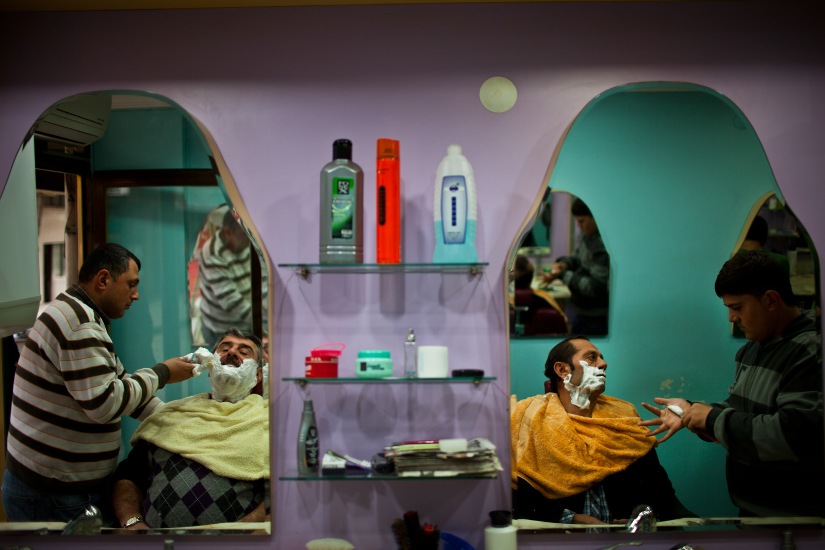 |
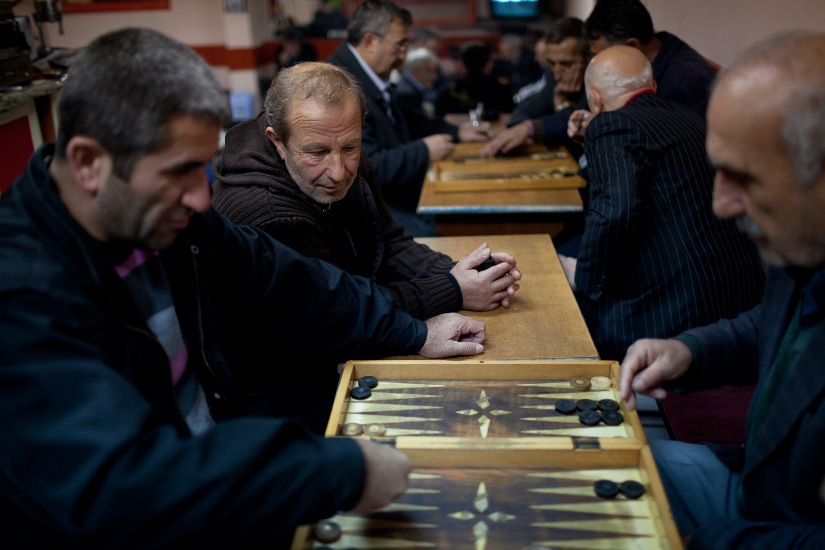 |
| Hopa: Men drinking tea, playing backgammon and getting a haircut in the town’s alleyways |
Hopa: Entertainment is for men only |
When the shop owner found out that we were from Armenia, a change came over him. He didn’t grow sullen like Hadji Süleyman, on the contrary, his face started to glow. “Do they know about us over there?” he asked. Khachik told him that they didn’t know all that much. “Eh…we sold our religion. We sold our Christianity and became Muslims.”
Even those Hamshens who avoid calling themselves Armenian and who regard themselves as Turks can’t escape the scorn heaped upon them by the other peoples of the region who call them ermeni in contempt. “I don’t know why but they call us ermeni kök,” said a village woman from Çamurlu. (Ermeni kök – Armenian offspring)
While the Hamshentsi-Laz conflict has subsided, this insult against their grandparents remains a sore spot within the souls of the Hamshens.
There’s a paradox at work here. On the one hand, the Turkish state apparatus has for years creating historical myths to pry the Hamshens from their Armenian roots, while on the other hand, local authorities and residents, by calling them Armenian in derision and persecuting them, have not allowed them to totally forget their Armenian origins.
Just like Hadji Süleyman in Başoba clearly remembers going to Mecca on pilgrimage as the most joyous time of his life, neither can he remove from his mind the years of persecution. “The Laz wouldn’t let us enter Hopa. They threw stones at us,” the old man related.
| Mumi Yilmaz: “My history is my grandfather. My grandfather came down from the mountains to sell whatever he had. They caught him, called him Armenian, and bashed his head in. They stole his belongings, his horse, everything.” | 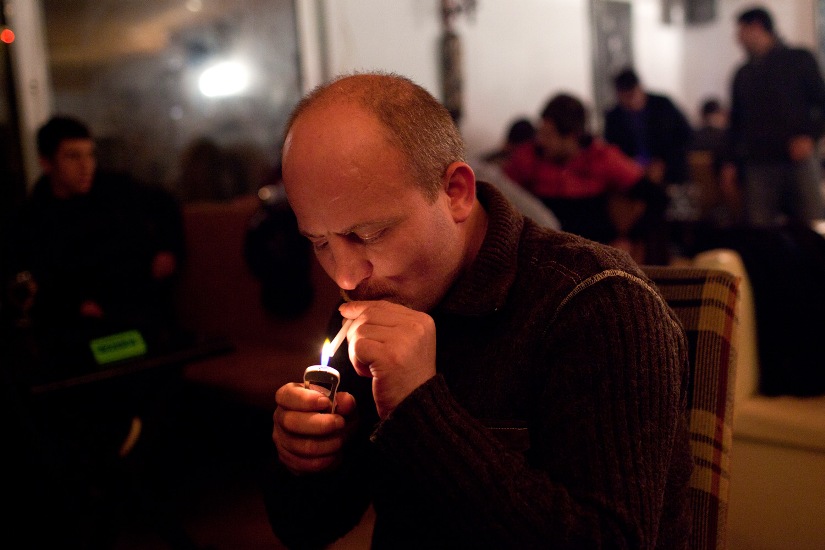 |
He was saying that the Laz aghas, (clan chiefs), held sway over these lands where the Hamshens enjoyed no legal defense. “And what about the Hamshen aghas,” I ask. “There were no aghas, all of us worked. None of the families had aghas,” Süleyman says.
The Hamshens had two ways out – to resist and remain the “cursed ones”, adopting the ideology of the oppressed masses, i.e. communism; or to become more Catholic than the Roman Pope, i.e. Turkish nationalists.
 |
|
“I don’t know why but they call us ermeni kök,” said a village woman from Çamurlu. |
Just as Mumi had done, when Aslan saw us enter the Hayteh Bar he welcomed us as friends with open arms.
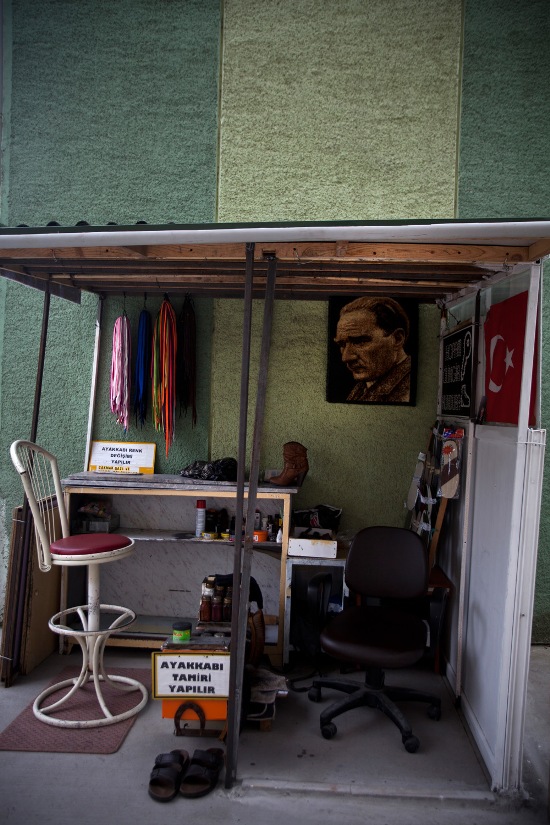 |
| Hopa: Kemal Ataturk’s photo is everywhere |
“I’m Armenian, I’m Armenian,” Aslan exclaimed as he vigorously shook my hand and invited us to join him. He attempted to converse with us only in Homshetsma. His other three table companions didn’t pay us any special attention. I figured they weren’t Hamshens. “They are Kurds and our friends. They are well aware that they massacred Armenians and are now sorry for their acts.” The Kurd sitting opposite me nods his head as if to say - of course.
“Turkey has two problems. It abhors two things; Armenians and communists. And I embody those two abhorrent things within me for I am Armenian and a communist,” Aslan says over and over. He makes a point to stress that he isn’t a Soviet communist and that he doesn’t accept the Soviet communist ideology, especially Stalin. “For me, Russia gave birth to three communists – Trotsky, Romas Kalanta and Lenin.” He utters the name of Lenin with some reservation.
Gradually, so many Hamshen entered the ranks of various leftwing movements that in 2004, Yılmaz Topaloğlu, a Hamshen and a communist, was elected as Hopa mayor for the first time. (He was elected from the Özgürlük ve Dayanışma Partisi (Freedom and Solidarity Party) and now is a member of the Eşitlik ve Demokrasi Partisi (Equality and Democracy Party).
Yılmaz Topaloğlu – A Communist and Hamshentsi Gets Elected Hopa Mayor
“I was the vehicle through which we were able to get a Hamshentsi communist elected as mayor for the very first time,” says 50 year-old Yılmaz. “Of course, our opponents said we knew nothing of politics, were wild and uncouth, and knew nothing but raising sheep. This is the kind of campaign they ran against us. But I am convinced that my tenure as mayor has been quite positive and I am proud to be the first Hamshentsi to have achieved such a position.”
The victory was short-lived. In the 2009 election, the Hamshen community nominated two left-wing candidates, splitting the left vote between them. This allowed the Laz candidate from the nationalist CHP (Republican People’s Party) to win. (Vote results: Yılmaz-2,200; other Hamshentsi-800; Laz-3,400)
“Even we add up my votes and the other left candidate’s, we still wouldn’t have won. But had we run a united campaign from the start we would have presented a much stronger team and could have gathered the votes to win,” says Yılmaz. “Nevertheless, even if there was a united Hamshentsi candidate it doesn’t mean that all Hamshentsi would have voted for him. The nationalists had stirred up anti-Armenian sentiments and created an atmosphere in which having an Armenian past is tantamount to a crime. And many Hamshentsis are still fearful of suddenly being identified as Armenians. Thus, when an election campaign claims that a candidate is Armenian, they come out in opposition.”
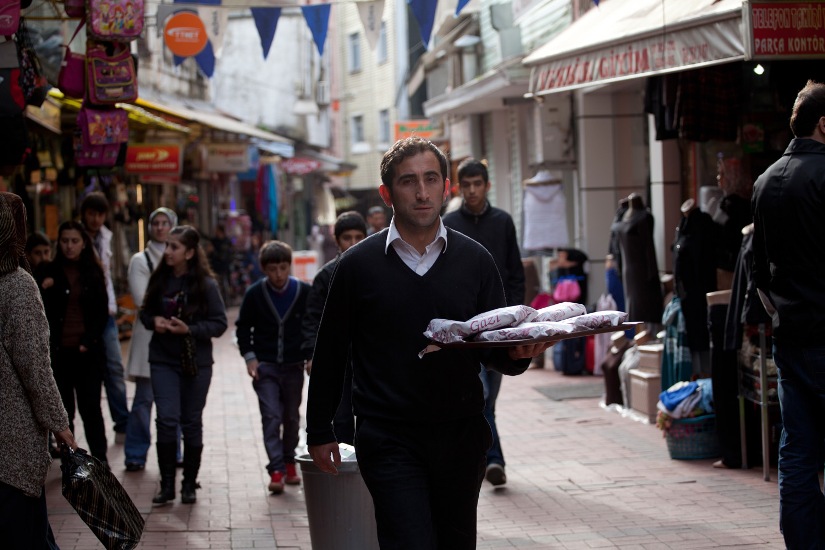 |
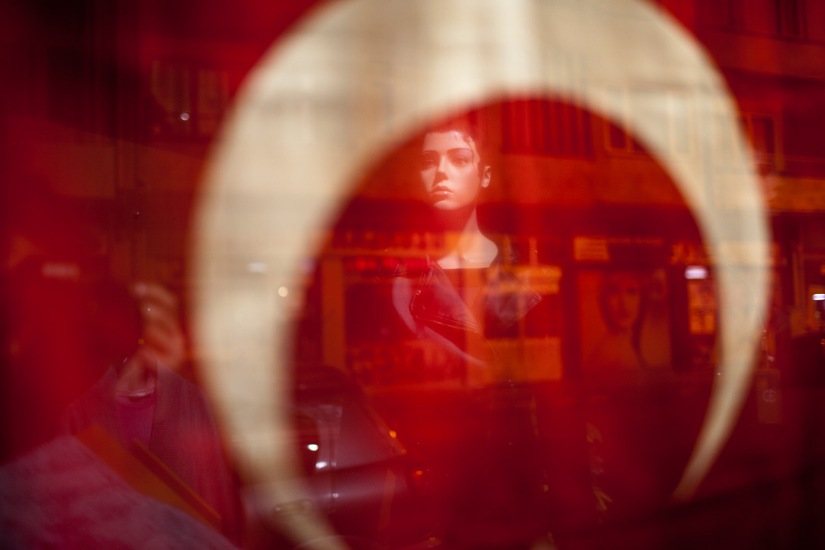 |
|
Hopa |
|
“Then again, our community has always been more in the opposition camp and hasn’t accepted the dictates of the center. They have always taken a more critical approach of everything. Thus the left is strong here with the potential to win. Tragically, the Laz are more pro-centrist, government backers, and struggle to defend their interests along with those of the government. It’s due to this that our political line suffers so.
Yılmaz says that as mayor he tried to give voice to the cultural problems of minorities, but that the central authorities created roadblocks.
“The first sparks of cooperation between the minorities can start with the arts and literature. We tried to organize festivals with the Hamshen and Laz communities. Then we launched a project with a Diyarbakir district leader regarding the confluence of cultures involving that town’s Kurds and the Laz and Hamshens from here. It really turned things upside down but it never ran to the end due to the intervention of the central authorities. Rumors spread that the Kurds and Hamshens were planning to unite against the government and demand independence. It was one of the reasons that we lost the mayor’s office; that they charged us with being opposed to the state and anti-Turk.”
Yılmaz is in construction and we met at his office in one of the buildings he’s developed. He also considers himself a communist. In his youth, he belonged to an illegal communist organization. After the 1980 coup, he was convicted and spent three years of torture in a Turkish jail. His first wife was a Hamshentsi. She and his daughter died in a car accident. Yılmaz then married a Turkish communist. They have a daughter and a son was born just days ago.
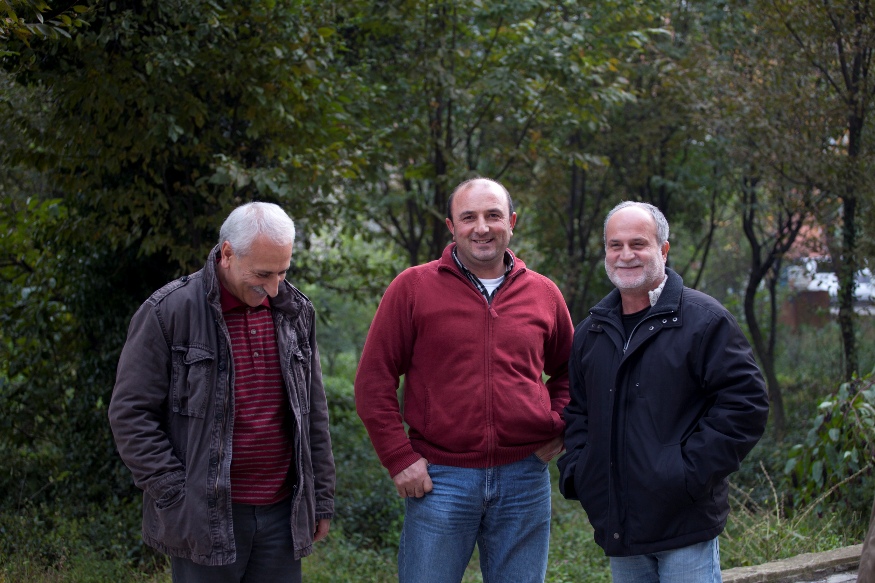 |
| Yılmaz and Ismet Topaloğlu, Khachik Terteryan. “When I drive my freight truck to Armenia I say my name is Topalyan. The reception I get is much warmer,” says Ismet. |
“Language plays a role in shaping a person’s essence. We speak our language, sing songs and even use it to mourn at funerals. You’ll never see people grieve in Turkish. The language makes us into something else,” says Yılmaz describing the Hamshens. “Our uniqueness lies in our fellowship. If something happens to one, all of us rush to help, but we also do not discriminate against those who are different from us. When I was mayor, I wanted our relations with the Laz to improve. Even though we have lived together for a few centuries, I can say that there hadn’t been more than ten mixed marriages.”
“After Hrant, we became more aware of our identity. Recently, I read a book written by one of Hrant’s friends and realized how close the Armenians are to us in terms of culture and language. After his death, our people’s Armenian consciousness grew and so did the cultural affinity we feel.”
All the while, the state and Turkish nationalists still derisively call them Armenians. To call someone Armenian or communist in Turkey is regarded as a curse; even today.
“They would point to us and charge us with being Armenian and communists. Right up till the late 1990s, Turkey was a terribly anti-communist country. It was due to European pressure and the collapse of the Soviet Union that conditions gradually changed. But the negative attitude towards Kurds and Armenians continues. They say that these peoples were former enemies of the Turkish state (he stresses that the Kurds also participated in the massacres of Armenians). This propaganda, sadly, is not only disseminated by the state but oftentimes by opposition elements. Despite claims to the contrary that Turkey is a multi-cultural nation, that all religions and nationalities constitute our richness, imbuing the country with colors and hues, they can’t come to grips with their anti-Armenian complex. They also seek to cover up the past regarding Armenians.”
Cemil Aksu: Eight Years of Torture in a Turkish Prison
 |
| Cemil Aksu: Yusuf, the hero in the film “Autumn” is based on his life |
“During the police questioning, when they found out that I was from Hopa, they asked me if I was Laz or Hamshentsi. I said I was Hamshentsi. ‘So you are ermeni?’ they said. ‘Yes, I am Armenian,’ I answered. Afterwards I became the object of a special sort of treatment. They cursed me as an Armenian. My eyes were bound and they beat me just because I was Armenian.”
34 year-old Cemil Aksu was a leftwing student activist in Samsun and was a member in the Marxist-Leninist Communist Party. In 1996, at the age of nineteen, he was arrested and charged with belonging to a terrorist organization. He spent eight years in prison – Ankara, Burdur, Bursa and Edirne. After being released, Cemil spent the next nine months in hiding in order to avoid military service. “I had just been released and they wanted to send me to the army. I wanted some free time.” He married and then served in the army for one and a half years. Today, he belongs to no political party but actively participates in and organizes various left-wing movements. He founded the civic cultural and environmental union, BirYaşam (One Life) and edits a monthly journal of the same name.
“Why did they bind your eyes?”
“In prison, my eyes were bound for days. They constantly tortured us and bound our eyes so what we couldn’t see who our torturers were. When they first arrested me I was detained for eight days before going to court. Before our court date, they gathered 18 of us in the hallway. Some government official showed us and read us a speech – why have you become followers of this one Armenian in whose hands you are mere toys?”
 |
| Yusuf: A scene from the film “Autumn” |
“What were the nationalities of the others?”
“One was my friend Erkan, a Hamshentsi. He’s now in Hopa. The others were left-wing Laz and Turks.”
I first heard of Cemil two years ago when I saw the Osjan Alper’s film Autumn. It tells the story of Yusuf, a Turkish prison inmate who is released but whose health has deteriorated as a result. I realize that Yusuf’s character was based on a real-life person; Cemil The only difference is that while Yusuf dies in the film, Cemil lives to tell the tale.
In the film, Yusuf has a romantic streak of heroism about him. True, Yusuf doesn’t commit any acts of heroism per-say in the film, but you can grasp an inner heroism in his eyes and comportment. Cemil exudes no such heroism. He relates his life of hell in prison with composure, as if it was just another common story. One gets the sense that he was destined to go down that road of life. Cemil also differs from the Soviet dissidents I knew who relate their acts of courage with pride and willpower forged in prison. Cemil neither portrays pride nor despondency; only calm. It was only when Cemil got a fever and started to cough for a few days that the image of Yusuf, from the film, suddenly appeared before my eyes. Yusuf too had taken nightmares and a cough from the prison with him; a weak but constant cough.
“What was your contribution to the film?”
 |
| Tea and more tea: Ustabaş Restaurant in Sheno |
“It dealt with the psychological state of a man released from prison – his feelings, how he fits back into the world outside, how he relates to people after such a long prison stretch. This was my contribution to the script. First, they used the letters I had sent from prison in the film. I also helped edit the dialogue in the Hamshen dialect.”
“We have heard much about the brutality in Turkish prisons. Can you talk about it?”
“Conditions were really awful until a few years ago, both in the jails and police stations. There’s torture and brutality in the police stations as well. I and my friends were subjected to constant torture for eight years. Ten inmates died in our prison alone. In 2008, or was it 2009, twelve people died in the Diyarbakir prison, all Kurds. In 2000, inmates in several prisons rebelled. 28 Kurds were killed and hundreds injured. Incidents of torture in Turkish police stations have dropped considerably of late and it’s because Turkey wants to become a member of the European Union. But brutality in the prisons persists.”
“How did they die?”
 |
| Cemil Aksu: “It’s entrenched in the minds of all in Turkey that the country has three enemies – Armenians, Alevis and communists.” |
“In one prison, for example, they had squeezed 100 inmates into a cell designed for 30. The guys organized a movement to change the conditions. In the middle of the night, the government moved in to crush the inmates. They used tear gas, bullets and set fires. That’s how so many died. The soldiers also beat the inmates mercilessly for the whole day. The victims were all socialists.”
What were the exact means of torture used?”
“Here are just two examples. First, they use electric shock on your body. Then, they hang you up by your arms and feet and pull you in opposite directions. That’s just the tip of what was done. They never treated the sick – no medications, no hospital. Oftentimes, the guards would come around just to beat the inmates.”
“Why did they constantly beat you? Did they beat you even if you kept your mouth shut and remained obedient?
“Yes and no. They’d often provoked the inmates, looking for any excuse to start the beatings. The guards would also make up new regulations on the spot to irritate you. Say someone sent you a book to read. The guards wouldn’t hand it over. Or if you were leaving your cell for a walk, they’d order you to strip and walk around naked. It’s all contrary to the law. But if you protested, it was an excuse to beat you. They would always find a convenient reason.”
“How did you withstand it?”
“You had no choice but to rely on your will to survive. You want to go on living and your inner dignity gives you the strength to resist.”
“Armenians and communists, does Turkey detest these two that much?”
“It’s entrenched in the minds of all in Turkey that the country has three enemies – Armenians, Alevis and communists. Such hostility is also reflected in school textbooks that propound – we are proud to be Turks, Turks are the best, all our neighbors want our lands, etc…The dominant ideology argues that whoever speaks Turkish is civilized. Other languages are viewed as barbaric. This approach is injected into all the people.”
“Is it because the Hamshens are a minority here and have been historically persecuted by the Turkish state that leftist political perspectives have taken root in Hopa and the surrounding area?”
“We are communities subjected to state persecution and I totally agree that what you describe plays a role. Our Hamshen identity is a very important factor and contributes greatly to our opposition to the central authorities. This is the undeniable sociological reality. The other causes are socio-economic.”
“How was it that you first were attracted to leftist ideas?”
“Our village was already entirely left-wing, same as now. Hopa is predominately left-wing and residents usually vote for leftists. But we always were aloof when it came to the central authorities and when the 1980 military coup happened tensions were further exacerbated. We used to receive many leftist papers here and that’s how my left-leaning foundation began.”
“Cemil, can you paint a picture of the political situation in Hopa today? What are the demands of residents?
 |
| Başoba: Women do all the housework |
“We have been politically active since long ago and one of the reasons is that we have continued the traditions of the elders. The other reason is the hard life of the villagers and the disintegration of the villages. It’s an ecological struggle as well against the construction of hydro-electric power stations. There’s also the issue of decentralized government. The Kurds are particularly active in advancing this demand so that local officials get the chance to solve local issues. Then there’s the cultural dimension. There are many nationalities living in here, in Giresun, Trabzon, Samsun, Rize and Artvin – Laz, Hamshens, Georgians, Greeks and Bosha (Roma) – which are on the verge on losing their language. The most active are the Laz, who are demanding that the language be taught in schools and that TV programs are broadcast in their language. The Georgians are also active. We, on the other hand, haven’t reached the point of making similar demands.”
“Do you want to make such demands?”
“It’s my belief all languages are worthy of surviving. The Hamshen language, like the others, must survive. Via government aid and through the activities of civic groups, we must spare no effort to preserve our culture. The main method to preserve the Hamshen language, just like Laz, Greek, Georgian, is through instruction. We must preserve our language by means of education.”
“What kind of success do you think it will have?”
Despite all the pressures to the contrary, Turkey is on the path of democratization and I’m hopeful that it will continue. If not, we are in store for a much more brutal regime. But since the whole world is on the road to democracy, we too are hopeful of moving in the same direction.”
“Given that the Hamshens are bearers of two cultures, the Armenian and Turkish, do you think they can serve as a bridge for cooperation between the two peoples and fomenting better relations?”
 |
| Hopa at night |
“I fully agree that the Hamshens share both Armenian and Turkish cultural elements. But in terms of Turkish-Armenian relations, in order to forge ties with Armenia, Turkey will be forced to come face-to-face with the genocide it committed and also acknowledge the spiritual and material damages that ensued. For example, ever since the founding of the Turkish Republic in 1923, they have constantly taught the people that Armenians are the enemies and that they betrayed us. Today, if we wanted to drastically change that approach, it would set off a powerful reaction amongst the masses. Hrant Dink was the greatest champion of friendly relations between Turkey and Armenia and he was murdered in front of our eyes. We can say that the state killed him. No one can deny it. Why does the Turkish government need to normalize relations with Armenia? I’d say mostly for trade reasons. Within Turkish society, however, the issues at play are more psychological and will not allow Turkish society to develop normal relations with Armenians. Overcoming this will be a long process. The first thing that needs to be done in Turkey is to cure the illness – nationalism, chauvinism and anti-Armenianism. Afterwards, it may be possible for the nationalities to live peacefully.”
“Do the Muslim Hamshens remember anything about the 1915 Genocide?”
“Many do. My grandfather would say that he saw what happened, but he probably heard stories from his father, a shepherd. It was when he was grazing sheep in the Ardanuç area and saw with his own eyes how a large group of Armenians were thrown into the abyss. One pregnant woman cried out, begging that she not be killed. They threw her over the edge as well. Gendarmes and soldiers took part in the killing. This incident took place at Hell’s Valley. Many over the age of fifty know about the massacres of Armenians.”
“Is it possible to collect what they know or have heard?”
“There is no serious collection, but I published this story in a left-wing newspaper. I’m now working on a paper that will tell the history of the Armenians of Arvin to be published in a scholarly journal. If you ask around, all are aware of the killing of the Armenians. There’s a village called Tandzout (land of pears). Everyone knows that it’s the name of an Armenian village.”
A Partial Return to Roots
The name of Cemil’s one and a half year-old son is Arev (Sun). The name of his uncle’s grandson is Lousenka (Moon).Cemil calls out another few names in the Hamshen language that have been given to children in the past few years – Jemna (Savior), Erand (Vigor), Tounes (It’s you). After an interruption of some three hundred years, the Hamshentsi are again giving their kids Armenian names. As a result, what we end up with is a Turkish-Armenian hybrid of first and last names – Arev Aksu; the name of Cemil’s son.
Levon Khachikyan, citing Hayk Bzhishkyan, writes that those half-Muslim, half-Christian Hamshentsis during the religious conversion phase had names that were half-Turkish and half-Armenian - Ali-Sargis Garabedoğlu, Mahmoud Hovhannesoğlu, etc.[1] Over time, the Armenian names faded, leaving only the Turkish. After the 1934 Surname Law, when Turkish names became obligatory, the Hamshens again lost their Turkish family surnames. For example the Aksu’s hailed from the Mouslioğlu clan, but the oghlu suffix was considered outdated according to the reform and had to be changed. In the same vein, the names Topaloğlu, Garabedoğlu and other clan surnames disappeared. They survived as names within the Soviet Hamshen community.
Just like the pressures brought to bear led to their full Armenian identity being transformed into an Armenian-Turkish mix, the freedoms of the last few years in Turkey have allowed them to bring back and reregister their names in the native language.
(to be continued)
Khachatur Terteryan assisted in the research work.
Photos by Anahit Hayrapetyan
Translated by Hrant Gadarigian
[1] Levon Khachikyan, Ejer hamshenahye patmutyunic (“Works” Vol. 2, Gandzasar Theological Center, Yerevan, 1999)
 Videos
Videos Photos
Photos
Comments (9)
Write a comment